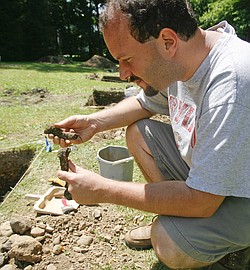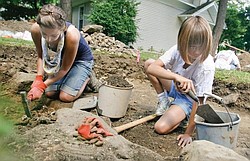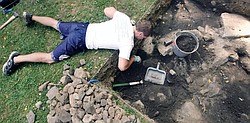They’re digging jail
The YSU students are excavating a jail dating to the mid-1800s.
By ELISE FRANCO
VINDICATOR STAFF WRITER
Archaelogical Dig in Canfield

Fourteen students in an advanced archeology field methods class at YSU are participating in a dig on a property next to the old Mahoning County Courthouse on Court Street in Canfield. Matt O’Mansky, class instructor, said the students have been working to uncover a jail dating back to the mid-1800s that is buried there. “I wanted to get them out there,” he said. “You don’t learn archeology in the classroom. You learn it out in the field.”
DIRTY WORK: Youngstown State University student Carla White, left, of McDonald, is assisted on the dig by 10-year-old Marissa Cashbaugh during a learning exercise on the site of the former courthouse. An advanced archeology class at YSU participated in the dig.
DIGGING DEEP: Joe Paloski, a graduate student at Youngstown State University, digs in a pit outside on the site of the former jail outside the old courthouse on Court Street in Canfield. The purpose of the dig was to explore the area’s history.
A GROUP OF YOUNGSTOWN STATE University students are digging into the history surrounding a county landmark.
Fourteen students in an advanced archeology field-methods class at YSU are participating in a dig on a property next to the old Mahoning County Courthouse on Court Street in Canfield.
Matt O’Mansky, class instructor, said the students have been working to uncover a jail dating back to the mid-1800s that is buried there.
“I wanted to get them out there,” he said. “You don’t learn archeology in the classroom. You learn it out in the field.”
O’Mansky said they work Wednesday through Saturday, eight hours per day. Each student is required to complete 64 hours, which is about eight days of work.
He has taught at YSU since 2005 and has taken several students on archeological digs to Mayan sites in Guatemala, but O’Mansky said this is his first dig in the area.
“I’ve been looking for something locally to do with my students,” he said. “I can usually only take a few students with me to Guatemala, so I wanted to do something nearby.”
For O’Mansky and his students, excavation is about more than just finding historical artifacts. He said instead of digging holes straight into the ground, the teams dig in layers across the grid. Not only does this help preserve artifacts, but it helps tell the story better, O’Mansky said.
“You need to lay out a grid, because if you know where in the site an artifact came from, it has more meaning,” he said.
“It’s all about putting the stuff together and fleshing out the lives of the people who lived here before.”
Molly Toth, 20, of Struthers, said they’ve already uncovered part of a jail wall in one of the pits she’s been working in, but she’d like to see more.
“It would be really great if we could uncover the foundation and figure out where it was in relation to the courthouse,” she said. “It’d be awesome to find a full bar from a [jail cell] window.”
Toth, who is a junior anthropology major, said this is something she’s been interested in doing for quite some time.
“I didn’t realize I could do it myself, and I was excited to be able to do this in real life,” she said.
O’Mansky said his students are learning as they go, and so is he.
“As building lines are emerging, they’re getting more excited,” he said. “We’re learning more about the local history. We found out the jail was built here to solidify the county seat.”
Matthew Slater, 29, of East Liverpool, said local history was one reason he joined O’Mansky’s class.
“I am looking at museum work, and this could possibly fall into my field,” he said. “As a historian, it’s definitely neat to see the end of it all.”
Slater said he would like to find a personal artifact.
“I’d like to find something personal to connect it with someone who was here at that time,” he said. “To get to touch something that been in the dirt for 100 years, that’s really cool.”
O’Mansky said he’s thankful Sonny Cashbaugh, the property owner, was willing to allow the class to dig on the land. Cashbaugh lives in the home next to the land, which is an extension of his lawn. His 10-year-old daughter Melissa even got in on the dig.
“I’ve been helping with some of the students,” she said. “I found the glass top part of a Heinz ketchup bottle.”
Melissa said living next door to a local historical landmark has taught her a lot.
“I’m really interested in history,” she said. “After living here ... it becomes way more intriguing.”
O’Mansky said Melissa isn’t the only community member to stop by the dig site.
“Sometimes people from the neighborhood even stop by to help,” he said. “People around here are really into their local history.”
The students are able to dig through August, O’Mansky said, and then they will cover the holes. He said since the excavation took place on private property, the Cashbaugh family will be able to keep anything the choose.
“The Cashbaughs are interested in incorporating some artifacts into their home,” O’Mansky said. “We’ll take any others they don’t want to the lab at YSU.”
efranco@vindy.com.
 43
43


